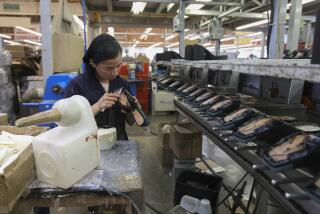China’s global trade surplus up 47%
SHANGHAI — Despite a series of product recalls that tarnished the “Made in China” label, the country’s global trade surplus jumped 47% in 2007 from the previous year to a record $262 billion, the government reported Friday. But exports grew at a slower pace last month, an indication of weakening demand tied to the teetering U.S. economy.
In December, China’s trade surplus fell to $22.7 billion from $26.2 billion in November. For the last three months, the value of China’s imports has grown faster than the value of exports. Although that was partly the result of higher prices for imports of oil and other commodities, if the trend continues it could curb China’s overall surplus and reduce tension with the U.S. and other trading partners.
For all of 2007, however, China’s total exports rose 25.7% to $1.218 trillion. Imports were up 20.8% to $955.8 billion, according to the General Administration of Customs. The resulting surplus was $262 billion, compared with $177.5 billion in 2006 and $102 billion in 2005.
In 2007, China’s biggest trade gap was again with the United States. By China’s count, that surplus amounted to $163 billion, up 13% from 2006. That was a slower growth rate than in recent years, as China’s imports from the U.S. last year grew faster than its exports to America.
It was the reverse for the European Union. China’s trade surplus with the EU widened 46% in 2007 to $134 billion. That has prompted stronger calls from EU leaders for Beijing to let the value of China’s currency rise significantly, which would tend to make Chinese goods more expensive in overseas markets.
In recent weeks, Beijing has stepped on the currency acceleration pedal as part of an effort to fight inflation. Last year, the yuan appreciated almost 7% relative to the dollar, and most analysts expect it to rise by as much as that or slightly more this year, which could take another bite out of Chinese exports.
Song Guoqing, an economics professor at Peking University, thinks China’s overall trade surplus will change little this year, thanks to a global economic slowdown, the run-up in the yuan’s value and last year’s removal of favorable tax policies for exporters.
China’s “government should be satisfied with the results,” Song said of December’s trade report. He said he expected U.S. and EU officials to soon ease pressure on Beijing over the trade surplus.
Other economists see a different scenario. Stephen Green, head of China research at Standard Chartered Bank in Shanghai, predicts that China’s trade surplus in 2008 will far exceed $300 billion. One key factor, he says, is that China is producing more of its own factory equipment and machines rather than importing them.
“This will be a historic year, the first since 1999 that China’s own economy has generated a surplus,” Green said. He added that China’s exporters might also capture extra market share in a global downturn by making more costly and sophisticated products or by further squeezing margins to maintain their sales growth.
By product category, China’s exports in 2007 were led by shipments of computers and other data-processing equipment and parts, which totaled $123 billion, an increase of 33% from 2006. Many of these goods, as well as other products with imported components, are assembled in China, where relatively little value is added before they are shipped to the U.S. and Europe.
China’s exports of apparel continued to show sharp increases, climbing 21% last year to $115 billion. Chinese steel shipments totaled $44 billion, up a whopping 68% from 2006.
For all of last year, Chinese exports of toys showed few ill effects from the problems over lead-tainted products. Last year, China shipped toys valued at $8.5 billion, up 20% from 2006. Full-year figures for food exports weren’t available Friday, but statistics through November show that Chinese farm products and food exports increased 17% to $32.5 billion.
As in past years, China’s leading imports continued to be commodities and resources to support the nation’s furious building of infrastructure, factories and other development. Imports of iron ore jumped 62% to $33.8 billion, and copper imports rose 58.5% to $19.7 billion.
--
Cao Jun in The Times’ Shanghai Bureau contributed to this report.
More to Read
Inside the business of entertainment
The Wide Shot brings you news, analysis and insights on everything from streaming wars to production — and what it all means for the future.
You may occasionally receive promotional content from the Los Angeles Times.










